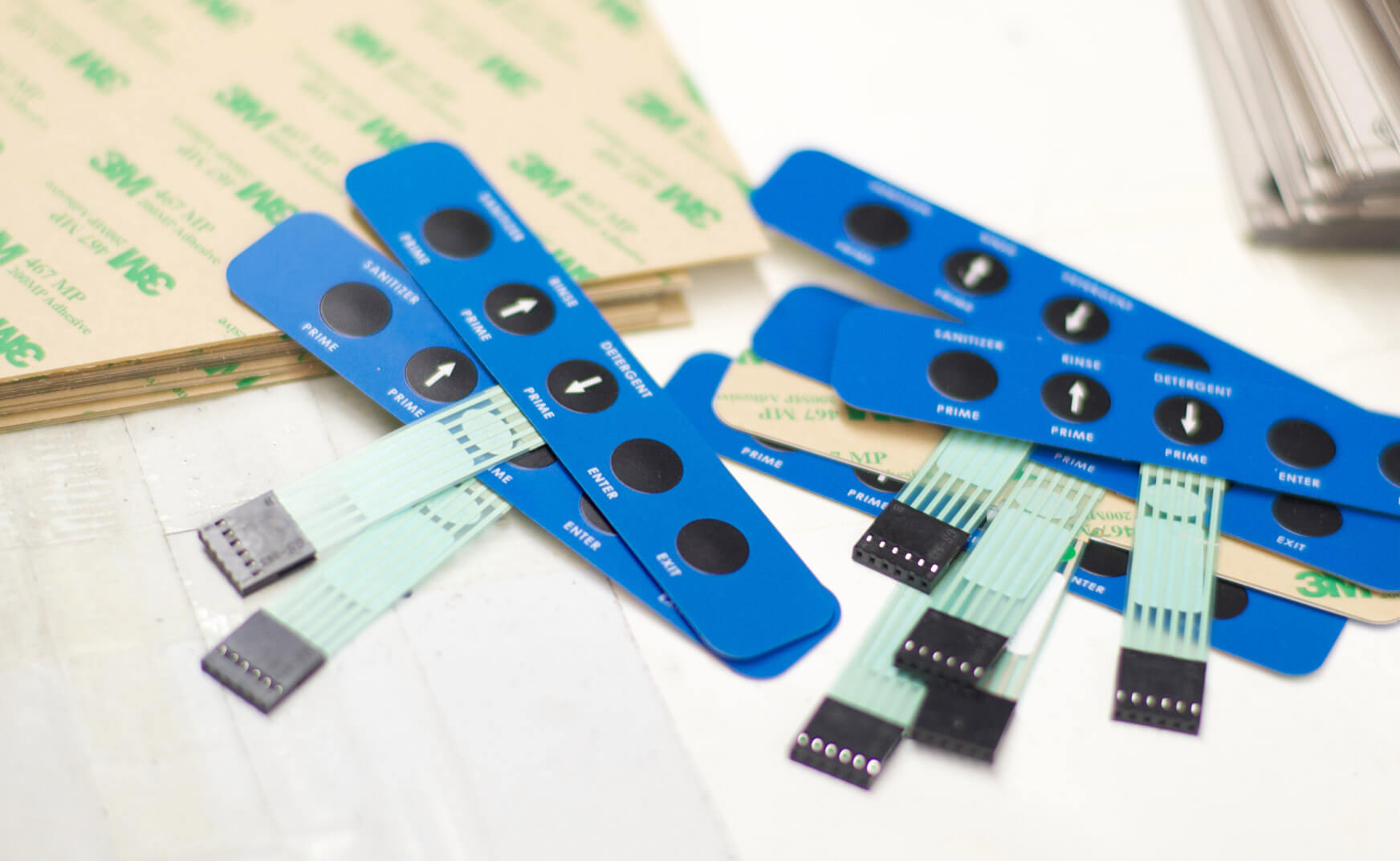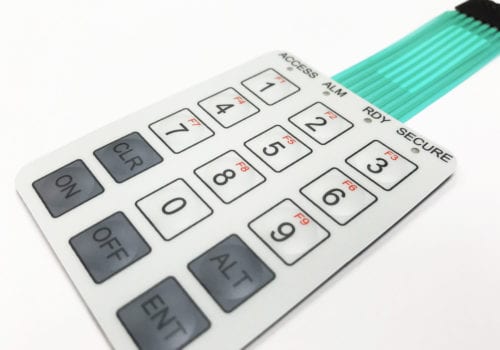The Role of Membrane Switches in Enhancing Product Aesthetics
The Role of Membrane Switches in Enhancing Product Aesthetics
Blog Article
Discover How Membrane Switches Feature and Their Duty in Modern Electronics
Membrane Switches stand for an advanced combination of technology and layout within the realm of modern electronic devices, acting as necessary interfaces in numerous tools. Comprised of multiple layers, these buttons utilize pressure-sensitive devices to assist in user communication. Their applications cover numerous industries, from consumer electronics to medical devices, highlighting their adaptability and significance. Recognizing the details of Membrane switch performance and their wider ramifications in enhancing individual experience welcomes more expedition right into their design, advantages, and the ingenious developments forming their future in modern technology.
What Are Membrane Switches?

Membrane switches are differentiated by their longevity and resistance to environmental factors, such as dust, moisture, and extreme temperatures. They can be customized with various graphics, colors, and tactile feedback options, boosting customer experience while keeping visual allure - membrane switches. In addition, the consolidation of printed circuits permits seamless integration into tools, boosting total performance.
The versatility of Membrane buttons appears in their capacity to support both basic and complex control features. They can include functions such as LED indications and touch-sensitive innovation, satisfying particular customer requirements. As modern technology proceeds to progress, Membrane Switches continue to be crucial for enabling effective and intuitive user interfaces, consequently playing an essential function in the innovation of modern electronic tools.
Parts of Membrane Switches
Membrane buttons are composed of several key parts that interact to produce a useful and dependable user interface. The key components consist of the visuals overlay, glue layer, spacer layer, and conductive traces.
The graphic overlay acts as the user interface, commonly published on an adaptable substrate such as polyester or polycarbonate. This layer not just supplies visual allure however also includes tactile comments, aesthetic cues, and safety features. Under the visuals overlay lies the sticky layer, which safeguards the button to the device and makes sure toughness against ecological anxieties.
The spacer layer is vital for maintaining the needed void in between the visuals overlay and the circuit layer. This void permits the activation of the switch when stress is used. The conductive traces, normally made from silver or carbon, create the electric pathways that finish the circuit when the button is involved.
Additionally, a backing layer might be consisted of for structural support and insulation. These components team up flawlessly, making certain that Membrane switches are both easy to use and resistant, making them crucial in different modern-day electronic applications.
Exactly How Membrane Switches Work
Just how do Membrane Switches feature efficiently within electronic tools? Membrane Switches operate on the concepts of pressure-sensitive technology, making use of a layered construction that consists of graphic overlays, adhesive layers, and conductive aspects.
The layout of Membrane buttons is important This Site for their efficient operation (membrane switches). The layers are thoroughly crafted to supply responsive feedback, durability, and resistance to ecological elements such as moisture and dust. The incorporation of domes-- tiny, increased locations within the button-- boosts tactile action, giving users with a recognizable click feeling upon activation
Furthermore, Membrane switches can be customized in terms of size, form, and graphics, making them appropriate for numerous applications. They are frequently used in control panels, medical tools, and consumer electronics as a result of their streamlined layout and dependability. Overall, the reliable functioning of Membrane switches is essential in improving customer interaction and ensuring seamless procedure in contemporary digital tools.

Applications in Modern Tools
Utilizing their special design and capability, Membrane buttons have ended up being essential components in a large range of modern digital tools. These functional interfaces are utilized in customer electronic devices, commercial equipment, clinical devices, and vehicle controls, providing seamless user interaction.
In customer electronic devices, Membrane switches are frequently located in home appliances like microwaves, cleaning machines, and other family gadgets, where they allow intuitive control with a smooth profile. Their inconspicuous style promotes assimilation right into small devices, improving aesthetic allure without jeopardizing functionality.
In commercial applications, Membrane Switches function as control panels for equipment, offering sturdiness and resistance to extreme settings. Their ability to withstand moisture and contaminants makes them perfect for use in production and handling sectors.
Clinical gadgets likewise gain from Membrane buttons, which are made to be simple to tidy and keep, guaranteeing health in medical setups. They are typically used in diagnostic devices, patient monitoring systems, and mobile clinical tools, where integrity is paramount.
Advantages of Membrane Buttons
One of the crucial benefits of Membrane switches is their versatility, which enables them to be tailored for a range of applications throughout several markets. These switches can be developed in various shapes and sizes, fitting special product needs while offering seamless assimilation into tools. Their thin account enables a streamlined and compact layout, usually improving the aesthetic appeal of electronic items.
An additional significant advantage is their resilience - membrane switches. Membrane buttons are typically immune to dust, moisture, and chemicals, making them excellent for extreme atmospheres. This resilience expands their life expectancy contrasted to conventional mechanical buttons, reducing the need for regular substitutes
Furthermore, Membrane Switches offer cost-effectiveness. The production process entails printing technologies that lessen manufacturing costs, specifically for big runs. This cost, combined with reduced upkeep needs, makes them an attractive my website choice for producers.

Final Thought
In final thought, Membrane Switches stand for a significant development in customer interface modern technology within modern electronic devices. As the demand for resistant and user-friendly you could try here user interfaces continues to expand, the role of Membrane switches in shaping customer experience will definitely expand.
Membrane Switches stand for an advanced assimilation of technology and design within the realm of modern-day electronics, offering as important interfaces in numerous tools.In the realm of modern electronic devices, Membrane Switches serve as vital elements that facilitate user interaction with gadgets. As modern technology proceeds to advance, Membrane Switches continue to be important for enabling effective and intuitive customer interfaces, thereby playing a critical role in the improvement of contemporary digital tools.
Just how do Membrane Switches function successfully within electronic tools? Generally, the effective functioning of Membrane buttons is pivotal in enhancing customer interaction and guaranteeing seamless operation in contemporary electronic tools.
Report this page